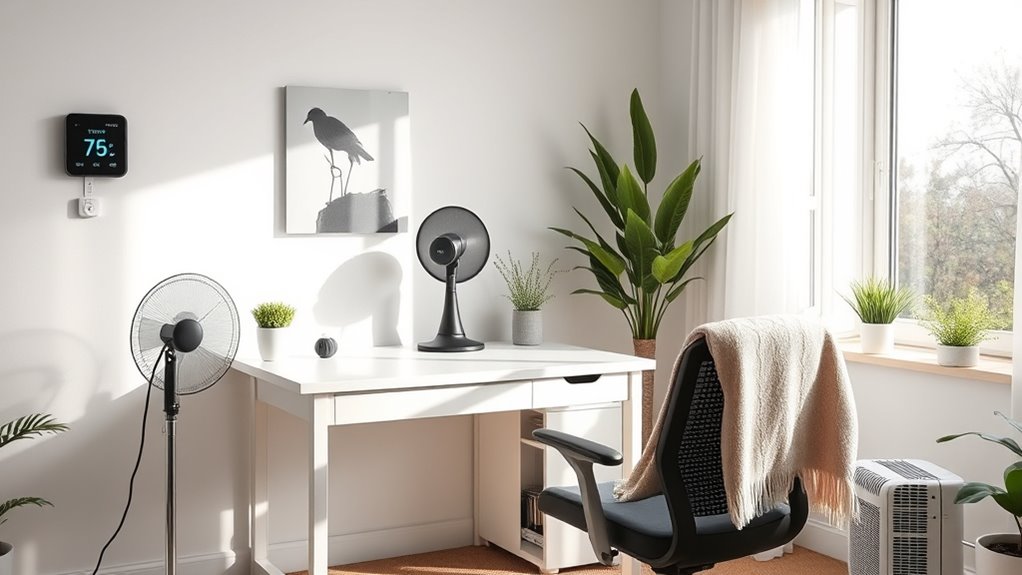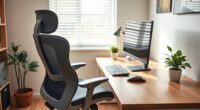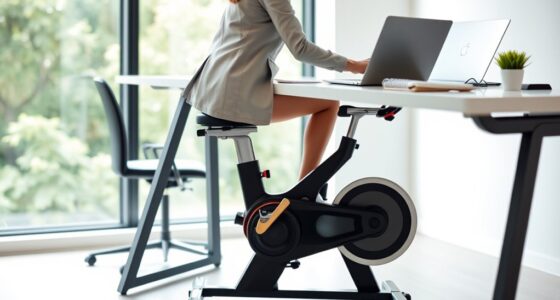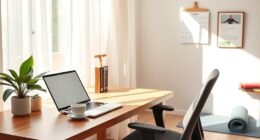To keep your home office comfortable, focus on optimizing window treatments like tinted windows, heavy curtains, or cellular shades to control sunlight and heat. Use portable fans and heaters wisely, placing them away from furniture for even airflow. Improve insulation around windows and doors to prevent drafts, and utilize natural ventilation—like opening opposite windows—for fresh air. Maintaining your HVAC system and using smart thermostats can also make a big difference. Keep exploring for expert tips to perfect your space.
Key Takeaways
- Install window tinting and heavy curtains to block heat gain and improve insulation.
- Use smart thermostats and portable fans or heaters for precise temperature adjustments.
- Seal gaps with weatherstripping around windows and doors to prevent drafts.
- Ensure HVAC maintenance, change filters regularly, and keep outdoor units clear of debris.
- Maximize natural ventilation by opening windows on opposite sides during cooler hours.
Optimize Your Window Treatments for Natural Temperature Regulation
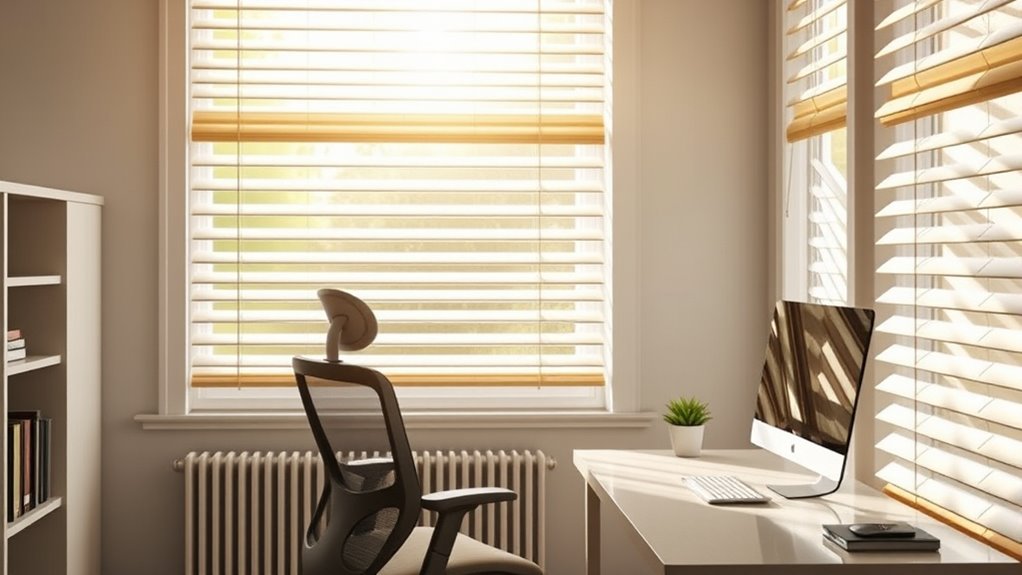
To naturally regulate the temperature in your home office, optimizing your window treatments is essential. Consider installing window tinting to reduce heat gain from sunlight while maintaining visibility. Tinted windows block infrared rays, keeping your space cooler during hot days. Additionally, improving window insulation helps prevent heat from escaping in winter and keeps outside heat out in summer. Weatherstripping around window frames seals gaps, reducing drafts and maintaining consistent indoor temperatures. Use heavy curtains or cellular shades that trap air and act as insulators. These treatments allow you to control sunlight and temperature without relying solely on HVAC systems. Properly assessing signs of spoilage in your existing window coverings can ensure they function effectively and safely. By enhancing your window treatments with tinting and insulation, you create a more comfortable, energy-efficient workspace year-round.
Use Portable Fans and Heaters Effectively

To get the most out of portable fans and heaters, focus on proper placement to maximize airflow and heating efficiency. Keep energy costs in check by using timers and adjustable settings, and always follow safety precautions to prevent accidents. With smart positioning and mindful use, you can stay comfortable without wasting energy. Additionally, choosing energy-efficient appliances can further reduce your utility bills and environmental impact.
Proper Placement Strategies
Proper placement of portable fans and heaters can make a significant difference in maintaining a comfortable home office temperature. To optimize their effectiveness, consider these strategies:
- Position fans and heaters away from furniture that blocks airflow, ensuring even temperature distribution.
- Use furniture arrangement to direct airflow toward your workspace, avoiding drafts or hot spots.
- Adjust for sunlight placement by placing heaters away from sunlit windows to prevent overheating, and position fans near shaded areas to circulate cooler air.
- Incorporate temperature regulation techniques to further enhance comfort and efficiency in your home office environment.
Energy Efficiency Tips
Using portable fans and heaters efficiently can substantially reduce your energy bills while keeping your home office comfortable. Position fans to promote airflow without overcooling or overheating the space, and set heaters to a comfortable temperature—around 68-70°F. Pair these with energy-efficient lighting options like LED bulbs to minimize electricity use. Improving your eco-friendly insulation helps maintain consistent temperatures, reducing the need for constant heating or cooling. When using portable devices, turn them off when not needed or when you leave the room. Keep windows and doors closed to prevent heat loss or gain. Combining these strategies ensures your home office stays comfortable while you save energy and lower costs. Efficient use of portable fans, heaters, lighting, and insulation makes a significant difference.
Safety Precautions
While portable fans and heaters can enhance your home office comfort, ensuring safety is vital to prevent accidents or hazards. To minimize risks:
- Always keep heaters away from flammable materials like paper, curtains, or furniture to prevent fire hazards.
- Regularly inspect electrical cords and outlets for damage, and never overload circuits to maintain electrical safety.
- Turn off fans and heaters when not in use or when leaving the room to reduce fire risks and conserve energy.
- Incorporating automation can help monitor and control device usage, enhancing safety and efficiency.
Keep Your Workspace Well Insulated
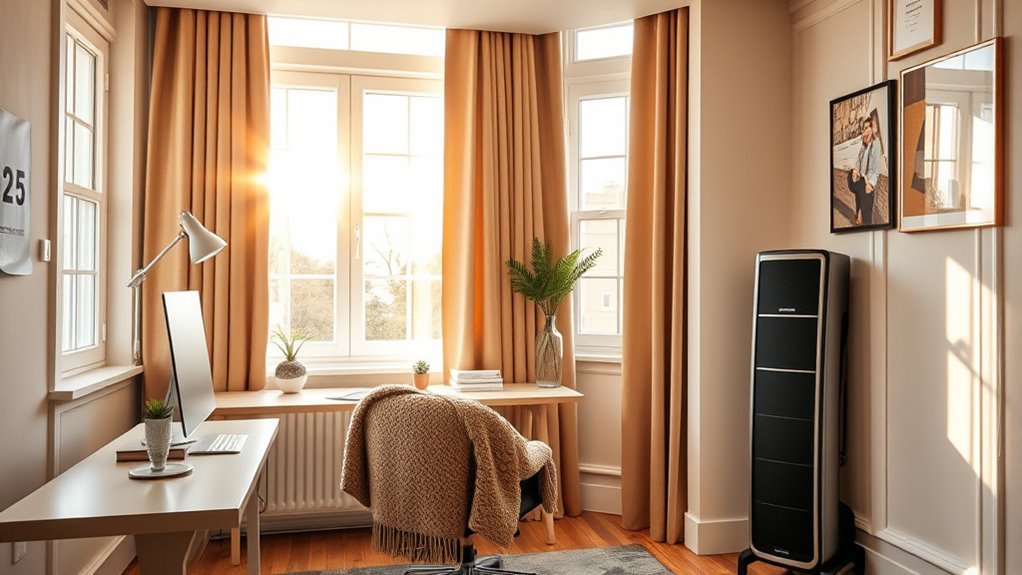
A well-insulated workspace helps maintain a consistent temperature and reduces energy costs. To achieve this, start by sealing gaps around windows with effective window insulation, preventing drafts that can cause uncomfortable temperature fluctuations. Installing weatherstripping or caulking around doors also helps block cold air leaks. Use door draft stoppers to seal the space at the bottom of doors, especially those leading outside or to unheated areas. These simple measures keep warm or cool air inside, making your heating and cooling systems more efficient. Proper insulation minimizes temperature swings and drafts, creating a more comfortable environment for work. Investing a little time in sealing leaks can markedly improve your home office’s temperature stability and reduce your energy bills.
Choose Appropriate Clothing and Layering Techniques
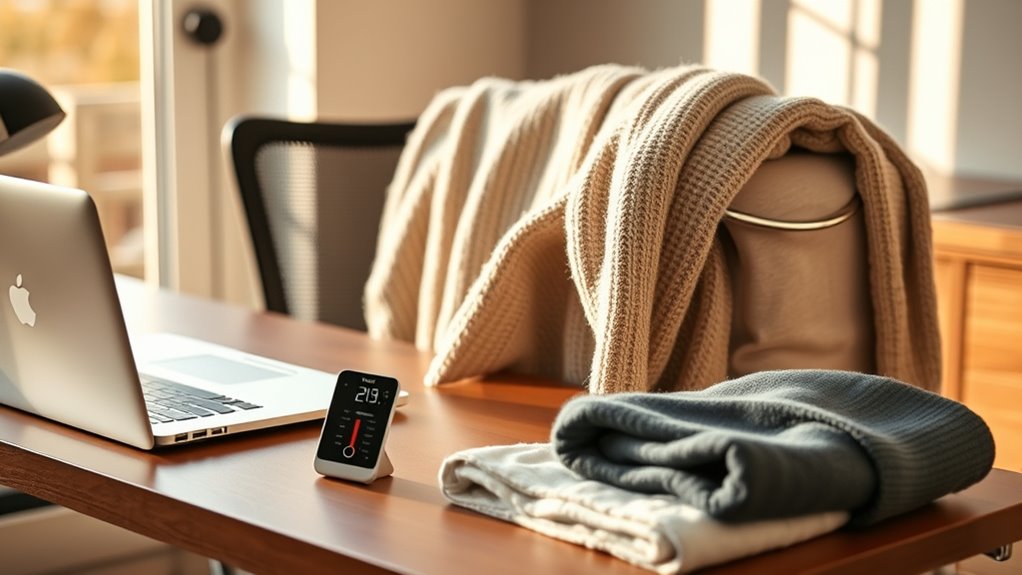
To stay comfortable in your home office, choose light layers you can add or remove as needed. Opt for breathable fabrics that wick away sweat and keep you cool or warm. Adjust your clothing throughout the day to match changing temperatures and stay productive.
Dress in Light Layers
Dressing in light layers is an effective way to stay comfortable as temperatures fluctuate throughout your workday. Layering techniques allow you to adjust easily without feeling overheated or chilly. Focus on:
- Wearing a breathable fabric base layer to wick away moisture and keep you cool.
- Adding a light, insulating middle layer for warmth when needed.
- Finishing with an easily removable outer layer if temperatures rise.
- Incorporating adaptable clothing options can help you respond to AI-driven environmental monitoring and other smart home technologies that optimize comfort.
Use Breathable Fabrics
Choosing breathable fabrics is essential for maintaining comfort in your home office, especially when temperatures shift. Breathable fabrics like cotton, linen, or moisture-wicking materials help regulate your body temperature and prevent overheating or chills. These fabrics allow air to circulate, enhancing thermal comfort during long work hours. Avoid synthetic fabrics that trap heat and moisture, as they can make you feel uncomfortable and sticky. When selecting clothing, opt for lightweight, breathable options and layer appropriately to adapt to changing conditions. Proper layering with breathable fabrics ensures you stay comfortable without overheating or feeling cold, keeping you focused on your tasks. Using breathable fabrics is a simple yet effective way to support your comfort and productivity throughout the day.
Adjust Clothing Throughout Day
Since temperatures can change throughout the day, it’s important to adjust your clothing accordingly to stay comfortable. Using effective layering techniques and fabric choices helps you adapt quickly. Consider these tips:
- Start with a breathable base layer made of moisture-wicking fabric to keep sweat away.
- Add or remove an outer layer, like a sweater or blazer, depending on the room temperature.
- Use lightweight, insulating fabrics such as wool or fleece for warmth without bulk.
- Regularly reassess your setup to ensure your clothing choices align with your environment and stay organized by creating designated zones for different clothing layers and accessories.
Adjust Your Desk Placement for Better Airflow

Positioning your desk strategically can considerably improve airflow in your home office. The right desk orientation can help you avoid stagnant air and promote cooling. Place your desk near windows or vents to enhance airflow pathways, allowing fresh air to circulate freely. Avoid blocking vents or placing your desk directly in the path of a fan, which can disrupt airflow. Consider the room’s natural airflow patterns and position your desk accordingly. Use the table below for ideas:
| Desk Orientation | Best Placement Tips | Airflow Pathways |
|---|---|---|
| Facing window | Maximize fresh air intake | Align with natural drafts |
| Away from vents | Prevent direct draft on you | Encourage circular airflow |
| Near open door | Promote cross-ventilation | Create continuous circulation |
| Center of room | Balance airflow throughout the space | Distribute air evenly |
Additionally, understanding airflow patterns can help you optimize your setup for a more comfortable environment.
Incorporate Temperature-Controlling Plants and Decor

Adding temperature-controlling plants and decor can considerably enhance your home office’s comfort. Plants like ferns or pothos help regulate indoor humidity, making the space feel more comfortable. Decor items such as light-colored curtains or reflective surfaces assist with natural light management, reducing glare and heat buildup. Consider these options:
- Use humidity-absorbing plants like Boston ferns or peace lilies to maintain *ideal* indoor humidity levels.
- Incorporate adjustable window treatments to control natural light and prevent overheating.
- Add reflective surfaces or light-colored decor to bounce sunlight and reduce heat absorption.
- Utilizing airless spray technology in decorating projects can help achieve smooth, professional finishes on furniture or wall accents, enhancing the overall ambiance.
These strategies help create a more stable environment, improving overall comfort without relying solely on HVAC adjustments. Incorporating such elements keeps your workspace naturally cooler and more inviting.
Maintain Your HVAC System for Peak Performance
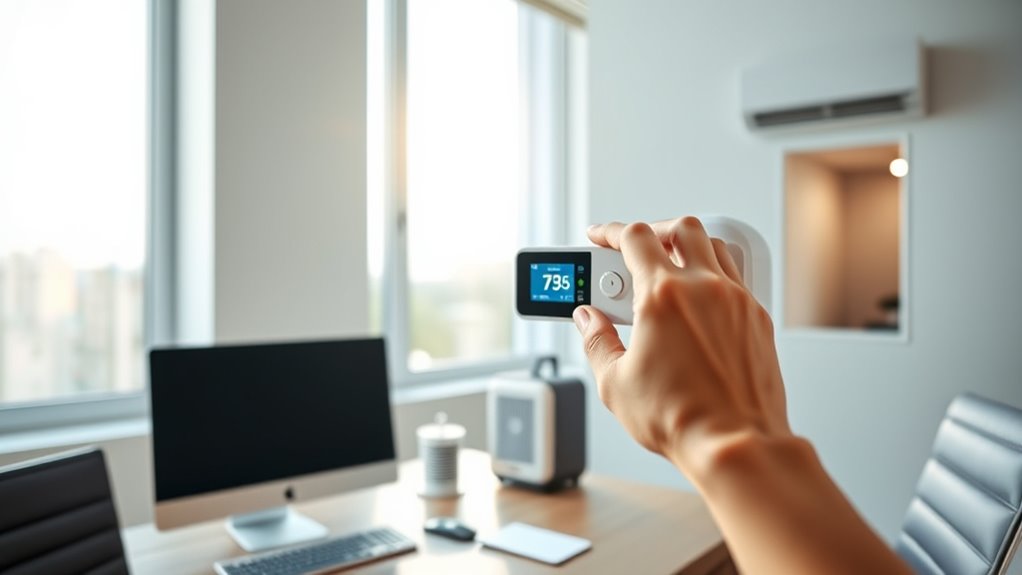
Regularly maintaining your HVAC system guarantees it operates efficiently and keeps your home office comfortable year-round. Schedule annual HVAC maintenance to ensure all components, like filters and coils, are clean and in good condition. Regular inspections help catch system troubleshooting issues early, preventing breakdowns and costly repairs. Change filters every 1-3 months to improve airflow and indoor air quality. Keep outdoor units free of debris and ensure vents aren’t blocked. If you notice uneven temperatures or strange noises, address these issues promptly to maintain peak performance. Proper HVAC maintenance extends the lifespan of your system and keeps energy bills low. Staying proactive with system troubleshooting and routine upkeep ensures your home office remains a comfortable, consistent environment. Additionally, understanding how airflow dynamics influence system efficiency can help you optimize your HVAC settings for better climate control.
Utilize Smart Thermostats for Precise Control
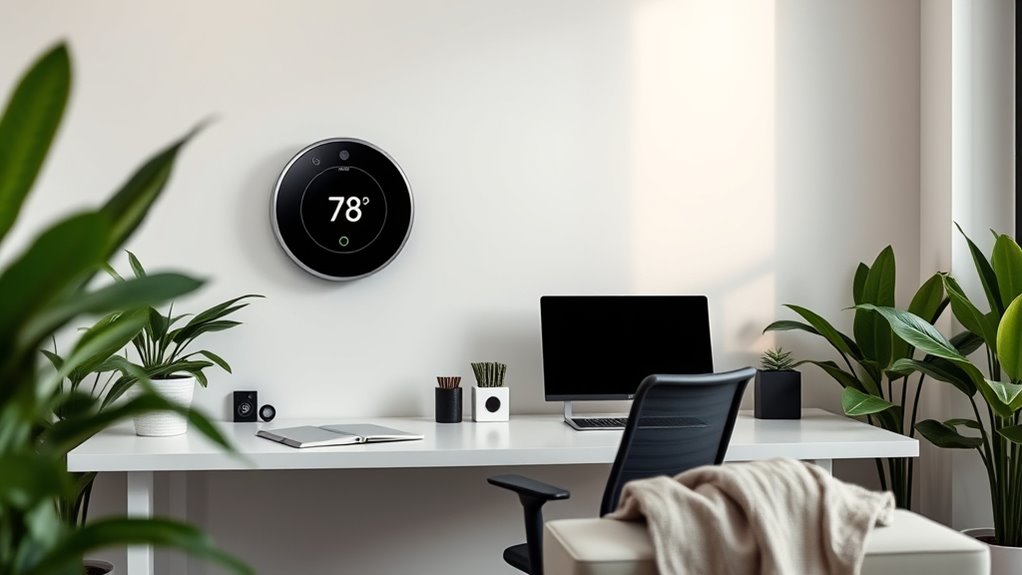
Smart thermostats offer precise control over your home office temperature, making it easier to create a comfortable environment. With features like temperature scheduling, you can set different temperatures for various times of the day, ensuring your space is always cozy when needed. To maximize their benefits, consider these tips:
- Use temperature scheduling to adjust settings automatically based on your work hours.
- Enable learning features that adapt to your habits for consistent comfort.
- Monitor your energy usage through the smart thermostat’s app to optimize efficiency.
- Regular calibration ensures accurate temperature readings and consistent performance color accuracy.
Create a Cross-Ventilation System to Enhance Air Circulation

Creating a cross-ventilation system can considerably improve air circulation in your home office, complementing your smart thermostat’s temperature control. By strategically opening windows on opposite sides, you promote airflow optimization and enjoy the cross ventilation benefits, like cooler temperatures and fresher air. To maximize effectiveness, consider the placement of furniture and barriers that may block airflow. During mild weather, keep windows open to encourage continuous air exchange. Use fans to direct airflow if natural ventilation is limited. Here’s a quick guide:
| Aspect | Tip | Benefit |
|---|---|---|
| Window placement | Open windows on opposite sides | Enhances cross airflow |
| Timing | Ventilate during cooler hours | Reduces indoor temperature |
| Barriers | Remove obstructions from vents | Improves airflow efficiency |
Additionally, incorporating natural ventilation strategies can help maintain a comfortable environment in your home office. This simple setup boosts airflow optimization and makes your home office more comfortable.
Frequently Asked Questions
How Can I Reduce Noise Distractions While Controlling Temperature?
To reduce noise distractions while controlling temperature, consider soundproofing solutions like sealing gaps around doors and windows. Acoustic treatments such as foam panels or heavy curtains can absorb sound and minimize disruptions. Keep your space comfortable by maintaining proper ventilation and using a fan or heater quietly. These steps help create a peaceful environment where temperature and noise no longer interfere with your productivity.
What Are Energy-Efficient Ways to Lower Heating and Cooling Costs?
To lower your heating and cooling costs efficiently, you should consider installing a smart thermostat, which adjusts temperature settings based on your schedule and preferences, saving energy. Additionally, improve your home’s insulation by sealing gaps around windows and adding window insulation film to prevent heat loss in winter. These steps help maintain a consistent temperature, reduce energy consumption, and cut costs while keeping your home comfortable year-round.
How Often Should I Service My HVAC System for Optimal Performance?
Think of your HVAC system like a well-tuned instrument needing regular care. You should service it at least once a year, preferably before the peak seasons. Regular HVAC maintenance keeps your system running efficiently, reduces breakdowns, and extends its system longevity. Scheduling professional checkups ensures maximum performance, saving you money on energy bills and preventing costly repairs down the line. Stay proactive for a comfortable, reliable home environment.
Can Certain Colors or Materials Influence Room Temperature?
Colors and materials definitely influence room temperature. Light colors, based on color psychology, reflect more heat, helping keep your space cooler. Darker shades absorb heat, making the room warmer. Material insulation also plays a role; thick curtains or insulated walls reduce heat transfer, maintaining a comfortable temperature. Choose light-colored walls and insulating materials to optimize your home office’s comfort and energy efficiency effortlessly.
Are There Eco-Friendly Options for Temperature Regulation in a Home Office?
You can choose eco-friendly options like installing solar panels to harness renewable energy and reduce your carbon footprint. Smart thermostats are also a great choice, as they allow you to efficiently regulate your home office temperature with minimal energy waste. By combining these solutions, you’ll maintain a comfortable space while supporting sustainability efforts, helping you save on energy costs and lessen environmental impact.
Conclusion
By implementing these tips, you’ll transform your home office into a cozy haven, where temperature feels just right—like a gentle breeze on a warm day. With a little effort, you’re fundamentally tuning your space like an instrument, creating harmony between comfort and productivity. So, take control of your environment, and let your workspace breathe easy, turning every workday into a smooth and comfortable journey.
